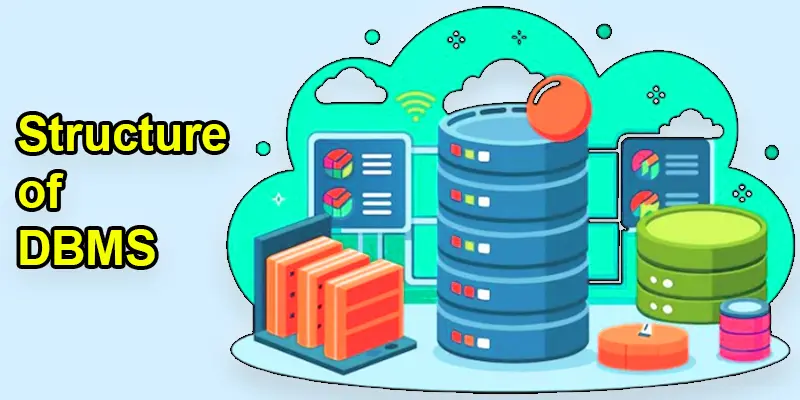DBMS | Structure of Database Management System
Published: 26 Sep 2024
Structure of DBMS in Database Management System
A database management system’s (DBMS) structure is built to store, manage, and retrieve data effectively. It includes different components, such as the user interface, application programs, and the database, which store the data. These parts work together to ensure data is stored, retrieved, and updated efficiently. The DBMS structure is designed to make data handling easier for users and developers by managing data securely. This structure is essential for keeping large amounts of information well-organized and easily accessible.
Difference Between Database Architecture and Tier Architecture
| Database Architecture | Tier Architecture |
|---|---|
| Focuses on the organization of data layers. | Focuses on separating system layers into tiers. |
| Manages data storage and access. | Divides application, server, and client responsibilities. |
| Typically, it has fewer layers (1 or 2 layers). | Can have multiple tiers (2-tier, 3-tier, or N-tier). |
| Users interact mainly with the database directly. | Users interact with the system through different tiers. |
| More static, focused on data storage. | It is more flexible and allows scalability by adding more tiers. |
Structure of DBMS with Diagram and Explanation
A database management system’s structure includes a disk manager, storage manager, query processor, transaction manager, and data engine. The following is an explanation of these:

Function of Query Processor in DBMS
The query processor is like a translator for the database. When you ask the database to find or change information, the query processor takes your request and converts it into commands that the database can understand. It then communicates with the database engine to get the results you need and sends them back to you. This makes it easy to interact with the database using simple, user-friendly queries.
Different Components of Query Processor in DBMS
The query processor has several key components:
- Parser: This part reads your query and checks it for errors. It makes sure the query is written correctly before processing it.
- Optimizer: This component looks at different ways to execute the query and chooses the most efficient one. It tries to find the fastest and most resource-saving method.
- Query Execution Engine: This part actually runs the query using the chosen method. It retrieves or modifies the data as requested.
- Planner: Based on the data and database structure, the planner determines the optimal query execution strategy. It works with the optimizer to plan the most effective execution strategy.
Role of Storage Manager in DBMS With Examples
The storage manager is like the librarian of the database. It handles how and where data is stored on the computer’s hard drive or server. It keeps track of where each piece of data is located, manages storage space efficiently, and ensures that data is saved and retrieved correctly. This helps keep the database organized and makes sure that information is easily accessible when needed.
Different Components of Storage Manager in DBMS
The storage manager has several important components:
- File Manager: This component handles how data files are organized and stored on the hard drive or server. It keeps track of file locations and ensures data is saved correctly.
- Buffer Manager: This part manages temporary storage (buffers) that hold data while it’s being processed. It keeps frequently accessed data in memory to speed up data retrieval and updates.
- Memory Manager: This component controls the allocation and deallocation of memory resources. It makes sure that the database has enough memory to operate efficiently.
- Disk Space Manager: This part keeps track of available disk space and manages how data is distributed across storage devices. It helps prevent data loss by ensuring there is enough space for all the database files.
Disk Storage in DBMS with Real-life Examples
Disk storage refers to the way data is saved on a computer’s hard drive or SSD. It’s like a digital filing cabinet where all your files and information are kept. Disk storage holds the data permanently, even when the computer is turned off, ensuring that everything you save is preserved and can be retrieved when needed.
Main Components of Disk Storage in Database Systems
The components of disk storage include:
- Hard Drive/SSD: The physical device where data is stored. A hard drive uses spinning disks, while an SSD uses flash memory for faster access.
- Disk Platter (for Hard Drives): The spinning disks inside a hard drive where data is magnetically recorded and read.
- Read/Write Head: This part moves over the disk platters to read or write data. It’s like a needle on a record player.
- Controller: This manages the communication between the disk storage and the rest of the computer. It controls how data is read from or written to the disk.
- Cache: A small, fast memory area that stores frequently accessed data to speed up retrieval times.
Role of Transaction Manager in DBMS System
The transaction manager is like a coordinator for database operations. It makes sure that all changes to the data are completed correctly and safely. If something goes wrong during a transaction, it can undo any changes to keep the data accurate and consistent. Essentially, it ensures that all parts of a transaction are completed or none at all, so the database remains reliable.
Components of Transaction Manager in Database System
The transaction manager has several important components:
- Transaction Log: This keeps a detailed record of all changes made during transactions. It’s like a diary that tracks every update, so changes can be reviewed or undone if needed.
- Commit Manager: This component confirms that all parts of a transaction are completed successfully and then saves the changes to the database. It ensures that the transaction is finalized properly.
- Rollback Manager: If something goes wrong, this part can undo changes made during a transaction to restore the database to its previous state. It acts like an “undo” button.
- Concurrency Control: This manages multiple transactions happening at the same time, ensuring they don’t interfere with each other and that the database remains consistent.
Database Engine in DBMS with Simple Explanation
The database engine is the core part of a DBMS that handles all the actual work of storing, retrieving, and managing data. It takes commands from users or applications, processes them, and interacts with the database to get the right information. Think of it as the engine in a car, driving all the functions and making sure everything runs smoothly.
Major Components of DBMS Database Engine
The database engine has several important components:
- Storage Manager: This handles how data is stored on disk, ensuring it’s saved and organized properly.
- Query Processor: This interprets and executes user queries, turning them into actions that the database engine can perform.
- Index Manager: This helps speed up data retrieval by creating and maintaining indexes, which are like quick-reference guides for finding information.
- Cache Manager: This stores frequently accessed data in memory to make data retrieval faster and more efficient.
What is Data Theft in Database Systems with Examples
- Definition: Data theft occurs when someone steals private or sensitive information from a database or computer system without permission.
- How It Happens: It can happen through hacking, phishing scams, or by exploiting security weaknesses in a system.
- What Can Be Stolen: Personal details, financial records, or confidential business data.
- Why It’s a Problem: Data theft can result in identity theft, monetary loss, and reputational harm to a business.
- How to Prevent It: Use strong passwords, keep software updated, and employ security measures like encryption to protect data.
Difference Between DBMS and Data Structure for Students
| DBMS | Data Structure |
|---|---|
| A system to manage and store large amounts of data. | A way to organize data for easy use. |
| Used for handling and managing databases. | Used in programming to arrange and process data. |
| More complex and handles large data systems. | Simpler, used for specific tasks within programs. |
| MySQL, Oracle, SQL Server. | Arrays, linked lists, trees, and graphs. |
| Focuses on overall data management. | Focuses on efficient data arrangement and access. |
Level of DBMS Architecture
The levels of DBMS architecture are like different layers of an organization, each with a specific role. Here are the main levels:
- Physical Level: The physical level is the lowest layer of a DBMS architecture. It deals with how data is stored on hardware like hard drives or SSDs. It focuses on the actual placement and organization of data files, ensuring that information is saved efficiently and can be retrieved quickly. Essentially, it’s about the physical details of storing data.
- Logical Level: The logical level defines the database’s structure without worrying about how data is physically stored. It organizes data into tables, defines relationships between different pieces of information, and specifies how data is linked. This level helps manage how data is arranged and understood, making it easier to work with and analyze.
- View Level: The view level is the top layer of a DBMS architecture that interacts with users. It defines how data is displayed and accessed by different users or applications. Each user might see a different view of the data based on their needs and permissions, making it easier for them to work with the information they need.
Schema Mapping in DBMS With Real-life Example
Schema mapping in DBMS is like creating a translation guide between different ways of organizing data. It helps to connect and align the structure of a database schema with other schemas or data formats. This ensures that data can be shared, understood, and used consistently across different systems or applications, even if they have different designs.
A Database Administrator’s (DBA) Role
The role of a Database Administrator (DBA) is to ensure that a company’s database runs smoothly and securely.
- Managing the database: Setting up, updating, and organizing the database to keep it efficient.
- Ensuring security: Protecting data from unauthorized access and ensuring data privacy.
- Backing up data: Regularly creating backups to prevent data loss in case of issues.
- Troubleshooting: Fixing any problems that come up with the database, like performance issues or errors.
- Optimizing performance: Making sure the database runs quickly and efficiently by tuning and maintaining it.

Conclusion About Database System Structure
We’ve covered the structure of DBMS in detail. I recommend drawing a simple diagram and reviewing each component like the query processor and storage manager through real examples. This will help you understand better and remember longer. If you’re still confused or need help, feel free to ask questions or share this with others who might benefit!
FAQS – Structure of Database System
The structure of DBMS includes several layers like the query processor, storage manager, and transaction manager. Each part helps store, manage, and retrieve data smoothly.
A database structure has tables, fields, rows, and columns. Its components include the DBMS engine, data, queries, and users.
The four main types are hierarchical, network, relational, and object-oriented. Each structure stores and links data in a different way.
A DBMS keeps data accurate and reliable by using Transaction Management to ensure all changes are done correctly and can be reversed if needed. It also uses Integrity Constraints to enforce rules on the data and regular Backups to prevent data loss.
- Internal Level: This is the lowest level and deals with how data is physically stored on disks.
- Conceptual Level: This level, which does not focus on specifics, specifies the general organization of the database and the relationships between various data items.
- External Level: This is the highest level and deals with how data is presented to users. It provides different views of the data based on what users need to see.
DBMS architecture is the design or layout that shows how data flows between users, applications, and the database. It can be 1-tier, 2-tier, or 3-tier.
DBMS is software like MySQL or Oracle that stores and manages data. For example, a library database that keeps track of books and members.
Common data types are integer (numbers), varchar (text), date (for dates), and boolean (true/false). These help define what kind of data is stored.
DBMS offers better data security, easy access, and less redundancy. It also allows multiple users to use the data safely at the same time.

- Be Respectful
- Stay Relevant
- Stay Positive
- True Feedback
- Encourage Discussion
- Avoid Spamming
- No Fake News
- Don't Copy-Paste
- No Personal Attacks

- Be Respectful
- Stay Relevant
- Stay Positive
- True Feedback
- Encourage Discussion
- Avoid Spamming
- No Fake News
- Don't Copy-Paste
- No Personal Attacks





